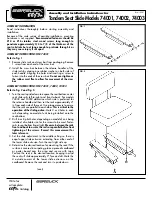
Road transport
42
Road transport
Safety
Before transporting the machine on public roads, please read the
following safety information. Compliance is mandatory and will help
you to avoid accidents.
Observe the safety information
Observe the safety information. Disregard for safety information
can lead to serious or fatal injury. See chapter »Safety«, page 6.
Ensuring road safety
The machine must conform to current national traffic regulations if
you intend to drive with it on public roads. Ensure the following:
•
Lighting, warning and protective equipment must be fitted.
•
The permissible transport widths and weights, axle loads, tyre
load-bearing capacities, laden weights and national speed
restrictions must be complied with.
•
The maximum permissible road transport speed must be
complied with, but not exceed 50 km/h.
•
The machine should only be towed by agricultural or forestry
tractors.
•
The empty weight of the tractor must be greater than the weight
of the machine.
The driver and keeper of the vehicle are liable should these
conditions not be observed.
Clean the machine before travelling on the road
Before travelling on the road, remove all coarse dirt, crop residues
and clods of earth from the machine and clean it. Crops or dirt that
drop onto the road can cause slippery road conditions. There is
otherwise the risk of traffic accidents and accidents with fatal con-
sequences.
Observe the contour of the terrain
Move the machine onto ground that is as flat as possible before
changing from work to transport position. Avoid inclines on which
the combination (tractor and machine) could slip or overturn. There
is an increased risk of tipping and injury in a position at right angles
to the direction of the slope.
Close the ball valve
Close the ball valve before driving on the road. If the ball valve is
open and there is an operating error, the machine may drop or swing
out unexpectedly. This could cause traffic accidents and accidents
with fatal consequences.
















































